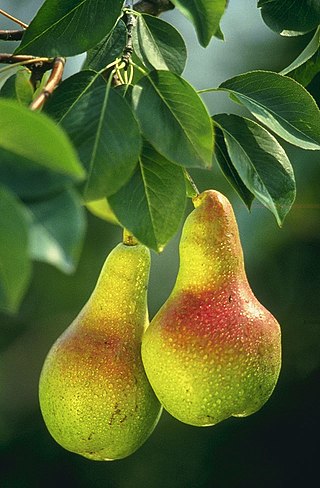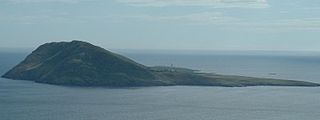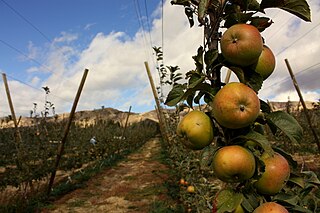Related Research Articles

Pears are fruits produced and consumed around the world, growing on a tree and harvested in the Northern Hemisphere in late summer into October. The pear tree and shrub are a species of genus Pyrus, in the family Rosaceae, bearing the pomaceous fruit of the same name. Several species of pears are valued for their edible fruit and juices, while others are cultivated as trees.

Fruit tree propagation is usually carried out vegetatively (non-sexually) by grafting or budding a desired variety onto a suitable rootstock.
Perry, also known as pear cider, is an alcoholic beverage made from fermented pears, traditionally the perry pear. It has been common for centuries in England, particularly in Gloucestershire, Herefordshire, and Worcestershire. It is also made in parts of South Wales and France, especially Normandy and Anjou, and in Commonwealth countries such as Canada, Australia, and New Zealand.

Pollination of fruit trees is required to produce seeds with surrounding fruit. It is the process of moving pollen from the anther to the stigma, either in the same flower or in another flower. Some tree species, including many fruit trees, do not produce fruit from self-pollination, so pollinizer trees are planted in orchards.

Bardsey Island, known as the legendary "Island of 20,000 Saints", is located 1.9 miles (3.1 km) off the Llŷn Peninsula in the Welsh county of Gwynedd. The Welsh name means "The Island in the Currents", while its English name refers to the "Island of the Bards", or possibly the Viking chieftain, "Barda". At 179 hectares in area it is the fourth largest offshore island in Wales, with a population of only 11.

Cider apples are a group of apple cultivars grown for their use in the production of cider. Cider apples are distinguished from "cookers" and "eaters", or dessert apples, by their bitterness or dryness of flavour, qualities which make the fruit unpalatable but can be useful in cidermaking. Some apples are considered to occupy more than one category.

The Flower of Kent is a green cultivar of cooking apple. According to the story, this is the apple Isaac Newton saw falling to ground from its tree, inspiring his laws of universal gravitation. It is pear-shaped, mealy, and sub-acid, and of generally poor quality by today's standards. As its name suggests, this cultivar likely originated from Kent, England.
A rootstock is part of a plant, often an underground part, from which new above-ground growth can be produced. It could also be described as a stem with a well developed root system, to which a bud from another plant is grafted. It can refer to a rhizome or underground stem. In grafting, it refers to a plant, sometimes just a stump, which already has an established, healthy root system, onto which a cutting or a bud from another plant is grafted. In some cases, such as vines of grapes and other berries, cuttings may be used for rootstocks, the roots being established in nursery conditions before planting them out. The plant part grafted onto the rootstock is usually called the scion. The scion is the plant that has the properties that propagator desires above ground, including the photosynthetic activity and the fruit or decorative properties. The rootstock is selected for its interaction with the soil, providing the roots and the stem to support the new plant, obtaining the necessary soil water and minerals, and resisting the relevant pests and diseases. After a few weeks, the tissues of the two parts will have grown together, eventually forming a single plant. After some years, it may be difficult to detect the site of the graft although the product always contains the components of two genetically different plants.

'Ambrosia' is a cultivar of apple originating in British Columbia, Canada in the early 1990s. The original tree was first cultivated by the Mennell family of Similkameen Valley, British Columbia, who discovered it growing in their orchard.
Ian Sturrock is a rescuer and restorer of orchards and apple trees, saving apple varieties from extinction. He discovered the last remaining Bardsey apple, and rescued the Diamond apple, as well as many other Welsh apples.

The Kingston Black, also known as Black Taunton, is a cultivar of apple originating from the United Kingdom and used in making cider. The name of the cultivar comes from the apples' dark red or purplish skin, though despite the name, the fruit does not have a black hue.

The Newtown Pippin, also known as Albemarle Pippin, is an American apple that originated in the late 17th or early 18th century and is still cultivated on a small scale. At one time, there were two very similar apple cultivars known as the 'Yellow Newtown' and 'Green Newtown', one of which perhaps originated as a sport of the other.

The Foxwhelp is a very old cider apple cultivar, originating in the west Midlands of England.

The Styre or Stire, also known as the Forest Styre, was an old English variety of cider apple which was formerly common in the Forest of Dean. It is currently thought to be extinct, but may still survive in old orchards or gardens.
Cider in the United Kingdom is widely available at pubs, off licences, and shops. It has been made in regions of the country where cider apples were grown since Roman times; in those regions it is intertwined with local culture.

In the United States, the definition of cider is broader than in Europe. There are two types: one is the traditional fermented product, called hard cider, and the second is sweet or soft cider. However, in some regions, cider is the alcoholic version, whether made from apples or pears, and apple cider is the non-alcoholic version.

The Woodcock was one of the oldest described English varieties of cider apple. It originated in the West of England in the counties of Herefordshire and Gloucestershire.
The Coccagee, also spelt 'Cackagee' or 'Cockagee' and sometimes known as the 'Irish Crab' or 'Lord Cork's Crab', is or was a variety of cider apple, known in Ireland and the West of England.
Cap of Liberty, also known by the name Red Soldiers or Bloody Soldier, is a traditional cider apple cultivar originating in the Martock area of central Somerset.

The cuisine of Monmouthshire is historically associated with Lady Augusta Hall, who was also known as Lady Llanover. Lady Llanover published one of the first Welsh cookery books called First Principles of Good Cookery. The book uses a fictional Welsh hermit to give culinary advice to a visiting guest who is travelling though Wales.
References
- ↑ "Welsh Names of Apples", The Cambrian Journal, Volume 111, 1858, p.145
- ↑ The Guardian Weekend , 6 October 2007, p.88
- ↑ Smith, Malcolm (22 March 2003). "The Sainted Apple". The Times. p. 12. Retrieved 16 February 2014.
- ↑ Tunstall, Jill (6 October 2007). "The man who rescues trees". The Guardian. Retrieved 16 February 2014.
- ↑ "Afan Ynys Enlli - Bardsey Island Apple" . Retrieved 16 February 2014.
- ↑ "Bardsey Island Apple". Ian Sturrock & Sons.
- ↑ "National Apple Register of the United Kingdom" Muriel Smith, Langford Press, Scotland 1971
- ↑ Hogg, Robert (1884). The Fruit Manual: a guide to the fruits and fruit trees of Great Britain. London: Journal of Horticulture Office.
- ↑ "Welsh Perry and Cider Society - Home". Welshcider.co.uk. Retrieved 31 October 2015.
- ↑ Researchers uncover 73 ‘new’ Welsh apple and pear varieties, retrieved 19 January 2019
- ↑ "Bardsey Island Apple Introduction". Bardseyapple.co.uk. Retrieved 9 January 2016.
